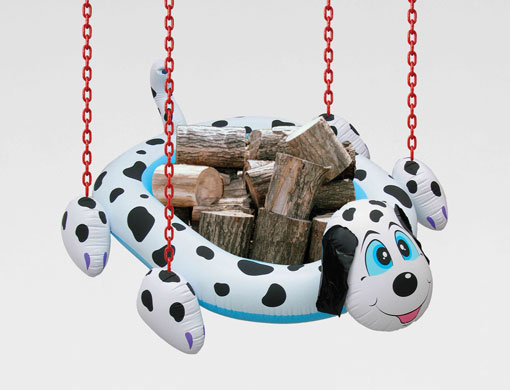
Jeff Koons, "Dogpool (Logs)," 2003-2008
In Herbert Ross’s magisterial 1987 film The Secret of My Success, Michael J. Fox plays Brantley Foster, a charming chancer who works his way up (spoiler alert!) from mailroom to boardroom in his uncle’s corporation. Meeting him in his plush corner office, Foster makes a heartfelt appeal to give him a chance in the company. “What experience have you had?” asks his flustered uncle. “Practically none,” says Foster. “But I believe in myself. Doesn’t that count for something? I can do anything if I just get a chance!” Here’s where audiences divide, both Europeans and Americans simultaneously responding, “That’s so American!” with exact opposite meaning and inflection.
Here, too, is where Jeff Koons’s work comes in, whose career and persona (like that of Michael J. Fox, or his late sometime muse, Michael Jackson) is so inextricably tied to the 1980s culture of capitalist optimism that it’s a mild surprise not to see his jacket sleeves rolled to the elbow in the press shots for his new show in London. The sober, side-parted 54-year-old may have retained the sartorial trappings of his commodities broker past, but in his work (and in his interviews), he has conserved a kind of wild-eyed naivety too consistently maintained to be prefixed faux with any degree of confidence. Consistency, too, is the keynote of his work as a whole. Trompe-l’oeil inflatables – sculptures in heavy metal meticulously finished to resemble weightless objects – have been a preoccupation of Koons’s work since the mid-eighties, when works such as Aqualung and Boat (both from 1985) announced the artist as a successor to Warhol’s deflating Pop persona. Inflatables again (and the idea of the inflated, tumescent, or pumped-up—all of which have, in various contexts, been applied to Koons and his work over the years) dominate proceedings at the Serpentine Gallery, in Koons’s first show in England, entitled Popeye Series.
Caterpillar Ladder (2003), which greets visitors to the Serpentine, resembles a children’s inflatable toy thrust through the legs of an ordinary stepladder, but is made from such extraordinarily finished aluminum that every wrinkle and pucker (sorry) looks utterly, impossibly convincing. Very bored-looking guards are stationed at every other sculpture, presumably to restrain the inevitable incredulous knocking; they can’t help but act as reminders of the insane cost of each work, and the gentle appeasement of nervous lenders (many works are on loan from private collections). Koons’s meticulous illusionism aligns his work more with Dali’s seamless dreamscapes than Duchamp’s dumpster-diving, although allusions to both abound. Lobsters out of Dali’s Lobster Telephone feature in several works (as do waxed moustaches), and chairs and dustbins and saucepans suspend from or support inflatable animals as a kind of nod to Duchamp’s assertion of aesthetic nullity.
Yet it’s the affirmation of the seductive power of illusion that makes Koons an anti-modernist in spirit and a Copperfieldian in practice. Modernist tastemaking demands deferral of an image’s resolution, a perpetual nudging reminder that what you’re seeing isn’t real. Koons’s work leaps into the subconscious without asking permission, setting off childhood conflations of pleasure and fear with lusty abandon. Dolphin (2003), a faux-inflatable suspended from the ceiling from emergency-yellow chains, carries a cargo of kitchen utensils from its belly in parody of domestic drudgery, even pregnancy, powering upwards in mad, unmistakably sexual transcendence. A kind of triumphalist surging characterizes the other sculptures on display, in which glossy, unblinking eyes and goofy smiles carry cartoon animals through physical obstacles and beyond their actual weight, like a vaguely traumatic dream before a job interview.
Meticulousness also characterizes the suite of paintings on display, all of which to some extent repeat the themes of the sculptures. So it’s hard not to think of them as secondary, especially since they lay bare Koons’s dependence upon Pop Art of the 1960s so baldly. A Ben-Day Popeye and airborne Superman make labored allusion to Lichtenstein and Warhol, and the layering of semi-translucent popular imagery makes no apparent advance on Rosenquist or even Wesselmann, as momentarily engaging as they are to unpick. The appearance of Popeye is a critical slippery slope towards creaky puns (an ‘eye for Pop’? ‘Eye-popping’?), but plays out the theme of the surge of pumped-up American strength pretty effectively (as do the two pairs of pneumatic breasts in Elvis (2003), a reminder of Koons’s not-at-all-SFW Made in Heaven series). Koons’s earnest assertion that the character, born in 1929, alludes to the Great Depression and thereby parallels our current economic strife is an excellent example of the artist’s bait-and-switch tactic, in work and in interviews; it’s both coldly ironic and utterly sincere. The works, at best, are both.
Inflation and its semantic offshoots have peppered much of the critical reaction to Koons, whose work (alongside the skull, or the gags) has perhaps unwittingly marked its place as icon of economic boom and bust—big shiny inflatable things in billionaire lobbies readily reducible as symbol of transient avarice. Critical (or, really, uncritical) hot air has buoyed Koons from show to show, continent to continent, like a balloon bopped between children at a party. But separating Koons’s work from its atmospheric environment, letting out the air of institutional obsequiousness, critical fawning and skyrocketing auction prices, leaves the viewer with a body of work in which pleasure – with all of its troubling associations and resonances – is the oxygen of art, with the orthodoxy of contemporary art theory sucked out. In the words of Ferris Bueller, in another mid-eighties masterpiece, “a person should not believe in an ‘ism.’ He should believe in himself.”




Pingback: What’s Cookin at the Art21 Blog: A Weekly Index | Art21 Blog